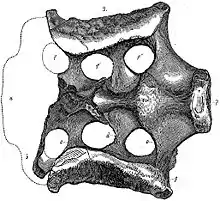Atlantosaurus
Atlantosaurus (meaning "Atlas lizard") is a dubious genus of sauropod dinosaur. It contains a single species, Atlantosaurus montanus, from the upper Morrison Formation of Colorado, United States. Atlantosaurus was the first sauropod to be described during the infamous 19th century Bone Wars,[1] during which scientific methodology suffered in favor of pursuit of academic acclaim.[2]
| Atlantosaurus | |
|---|---|
 | |
| Illustration of the sacrum of A. montanus | |
| Scientific classification | |
| Kingdom: | Animalia |
| Phylum: | Chordata |
| Clade: | Dinosauria |
| Clade: | Saurischia |
| Suborder: | †Sauropodomorpha |
| Clade: | †Sauropoda |
| Clade: | †Eusauropoda |
| Clade: | †Neosauropoda |
| Family: | †Diplodocidae |
| Genus: | †Atlantosaurus Marsh, 1877 |
| Species: | †A. montanus |
| Binomial name | |
| †Atlantosaurus montanus (Marsh, 1877) | |
| Other species | |
| |
| Synonyms | |
| |
History
The type specimen, YPM 1835, found by Arthur Lakes in Lakes Quarry Number 1 in the Morrison Formation of Colorado, United States, was named and described by Othniel Charles Marsh, Professor of Paleontology at Yale University (then called Yale College), in July 1877 as Titanosaurus montanus.[3] Marsh soon learned that the name Titanosaurus had already been used earlier that year by Richard Lydekker to describe a different sauropod from India, so he renamed it Atlantosaurus montanus. Marsh estimated the length of the animal at twenty-four metres, "if built like a crocodile".[4]
The skeletal remains discovered, two or three posterior sacral vertebrae connected to the ilia, were initially distinguished by their immense size and by the pleurocoels (air-filled pockets) in the vertebrae. However, since the time of its discovery, these features have been found to be widespread among sauropods, making it nearly impossible to distinguish the two known vertebrae of Atlantosaurus from those of its relatives. Since it is unclear whether or not Atlantosaurus montanus actually represents a distinct species, it is considered a nomen dubium ("dubious name"),[5] though some researchers have considered it a likely synonym of Apatosaurus ajax.[2][6]
In 1878, Marsh named a second species, Atlantosaurus immanis, "the immense one", based on holotype YPM 1840, a thighbone, pubic bone and ischium, also found by Lakes, in Quarry Number 10. Marsh estimated its length at thirty-five metres from a presumed thighbone length of 2.5 metres.[7] Later the femur length was determined at 1.95 metres. The specimen was in 2015 identified as a member of the Apatosaurinae.[8]
 Early life restoration of Atlantosaurus immanis, at the time seen as the largest land animal in history
Early life restoration of Atlantosaurus immanis, at the time seen as the largest land animal in history Image of the cast of the femur of Atlantosaurus immanis. From a cast in the Natural History Museum, London. Length 6 feet, 2 inches. Plate XVIII
Image of the cast of the femur of Atlantosaurus immanis. From a cast in the Natural History Museum, London. Length 6 feet, 2 inches. Plate XVIII
References
- Wilson, J. A. (2011). "Anatomical terminology for the sacrum of sauropod dinosaurs." Contributions from the Museum of Paleontology, University of Michigan, 32(5): 59-69.
- Taylor, M.P. (2010). "Sauropod dinosaur research: a historical review." Pp. 361-386 in Moody, R.T.J., Buffetaut, E., Naish, D. and Martill, D.E. (eds.), Dinosaurs and Other Extinct Saurians: A Historical Perspective. London: The Geological Society, Special Publication No. 34.
- Marsh, O.C. 1877. "Notice of a new and gigantic dinosaur". American Journal of Science, series 3, 14: 87–88
- Marsh, O.C. (December 1877). "Notice of New Dinosaurian Reptiles from the Jurassic formation" (PDF). American Journal of Science. 14 (84): 514–516. Bibcode:1877AmJS...14..514M. doi:10.2475/ajs.s3-14.84.514.
- McIntosh, J. S. (1990). Sauropoda. In D. B. Weishampel, P. Dodson, and H. Osmólska (eds.), The Dinosauria, University of California Press, Berkeley, 345-401.
- Berman, D.S. and McIntosh, J. S. (1978). "Skull and relationships of the Upper Jurassic sauropod Apatosaurus (Reptilia, Saurischia)." Bulletin of the Carnegie Museum, 8: 1–35.
- Marsh, O.C. 1878. "Notice of new dinosaurian reptiles". American Journal of Science, series 3, 15: 241–244
- Tschopp, E.; Mateus, O. V.; Benson, R. B. J. (2015). "A specimen-level phylogenetic analysis and taxonomic revision of Diplodocidae (Dinosauria, Sauropoda)". PeerJ. 3: e857. doi:10.7717/peerj.857. PMC 4393826. PMID 25870766.
External links
- "Morrison Natural History Museum web site". Archived from the original on September 24, 2006. Retrieved June 5, 2006.












